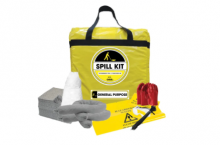An oil spill kit is an invaluable resource designed to address and manage oil spills efficiently, ensuring rapid containment and cleanup to mitigate environmental impact and enhance safety. These kits are essential across a range of settings, including industrial facilities, marine environments, and laboratories.
Components of an Oil Spill Kit
An oil spill kit typically includes various tools and materials specifically designed to tackle oil spills:
Absorbent Pads, Booms, and Socks: These absorbent materials are designed to soak up oil while repelling water, making them particularly effective in both land and aquatic environments.
Personal Protective Equipment (PPE): Items such as gloves, goggles, and coveralls are included to protect responders from hazardous substances during the cleanup process.Disposal Bags and Ties: These are used for the safe and efficient disposal of contaminated materials, ensuring a thorough cleanup.
Variety in Spill Kits
While oil spill kit are specialized for oil spills, other spill kits are designed for different hazardous substances. For example, a chemical spill kit is tailored to handle chemical spills and includes neutralizers, specific absorbents, and chemical-resistant PPE. Selecting the appropriate spill kit for the substance involved is crucial for effective spill management.
Applications and Benefits
Industrial Settings
In industrial environments where oils and other hazardous liquids are frequently used, an oil spill kit is indispensable. These kits help prevent accidents, minimize downtime, and ensure compliance with safety regulations. Rapid spill response reduces the risk of injuries and environmental contamination, protecting both workers and the surrounding area.
Marine and Coastal Areas
Oil spills in marine and coastal areas can have severe environmental consequences. An oil spill kit designed for marine use includes floating booms and absorbents that can be quickly deployed to contain and clean up spills on water. This immediate response capability is essential for protecting marine ecosystems and maintaining water quality.
Laboratories and Medical Facilities
In laboratories and medical facilities, both oil spill kits and chemical spill kits are crucial for maintaining a safe working environment. These settings often involve handling various hazardous substances, making quick and effective spill management necessary. Having the appropriate spill kits ensures that spills are addressed promptly, protecting personnel and preventing contamination.
Regulatory Compliance
The presence of an oil spill kit is often mandated by environmental and safety regulations. These regulations require facilities to have the necessary equipment to manage spills effectively, helping to avoid legal penalties and demonstrating a commitment to environmental stewardship and workplace safety. Compliance with these regulations ensures that facilities are prepared to handle spills responsibly.
Training and Preparedness
Equipping a facility with oil spill kits and chemical spill kits is a proactive measure, but it is equally important to train personnel in their proper use. Regular training sessions and spill response drills help ensure that staff are prepared to respond quickly and effectively to spills, minimizing risks and ensuring a swift cleanup process.
Conclusion
An oil spill kit is a critical component of spill response strategies across various settings. Its role in preventing environmental damage, ensuring safety, and maintaining regulatory compliance is invaluable. Whether in industrial settings, marine environments, or laboratories, having the appropriate spill kit and trained personnel ready to respond to spills is essential for mitigating risks and protecting the environment. Investing in these kits and ensuring comprehensive training reflects a responsible and proactive approach to spill management and environmental protection.
